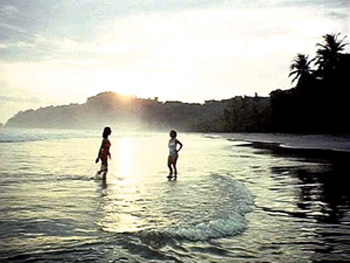Evidence of human occupation of Costa Rica dates back 10,000 years, but unlike the Mayas, Olmecs and Aztecs to the north and Incas to the south, the tribes who inhabited the area never organized into larger societies.
The first European to discover Costa Rica was Christopher Columbus, who landed there in 1502 on his fourth and final journey to the New World and stayed briefly to repair his storm-damaged ships. Twenty years later, the gold worn by the natives inspired the Spanish Conquistador Gil González Dávila to name the area Costa Rica, or “Rich Coast.” This proved to be misleading, however, as harsh terrain, tropical diseases and antagonistic natives made the area remarkably difficult to colonize.
 After
numerous failed attempts, the first successful settlement, Cartago, was
established in 1562. However, a scarcity of easily obtained resources
and lack of a large native population to serve as a workforce inhibited
widespread colonization. Many of the indigenous people fled or were wiped
out by European diseases, and the colonists were forced to work their
own land. This need to "do it yourself" led to Costa Rica’s
egalitarian social structure.
After
numerous failed attempts, the first successful settlement, Cartago, was
established in 1562. However, a scarcity of easily obtained resources
and lack of a large native population to serve as a workforce inhibited
widespread colonization. Many of the indigenous people fled or were wiped
out by European diseases, and the colonists were forced to work their
own land. This need to "do it yourself" led to Costa Rica’s
egalitarian social structure. In 1821, Costa Rica gained its independence from Spain, but remained part of a loose federation of Central American states until 1848, when José María Castro was elected as the country’s first president. The powerful coffee barons, whose product had become the country’s primary export crop, used the army to oust Castro from the presidency and replace him with one of their own, a coffee grower named Juan Rafael Mora. His first major task was to deal with the American filibuster William Walker.
William Walker was a Southerner who led a campaign to conquer various Latin America countries in order to create a vast slave state and fulfill the concept of Manifest Destiny. He had tried to take over Baja and Sonora in Mexico, and Nicaragua, and in 1856 planned to invade Costa Rica from Nicaragua. In response, Mora raised an army of 9000 peasants, who marched into Nicaragua and defeated Walker, forcing him to flee to Honduras, where he was captured and executed. The victory produced a newfound sense of national unity that swept over the country.
Illogically blamed for a cholera epidemic that caused the death of 10% of the population, Mora was overthrown and executed in 1859, and the coffee elite jostled for the presidency until 1870, when General Tomás Guardia took control.
Guardia’s presidency was effectively a military dictatorship, but his leadership was surprisingly progressive. During his 12-year rule he abolished capital punishment, established free education for both sexes, improved roads, instigated the construction of a major railway, and limited the power of the army—an ironic move by a man who used the same army to secure his own power.
In the late 19th and early 20th centuries, Costa Rica opened itself to virtually unregulated foreign investment and accrued significant amounts of debt. Poor working conditions at the United Fruit Company, a major banana operation, and other industries led to a number of strikes, which often ended violently. Because American companies were deeply involved in Costa Rican business and represented a huge export market, Costa Rica’s economy took a massive blow when the Great Depression hit in 1929. The country weathered the Depression only to be rocked by civil war.
In the election of 1948, President Teodoro Picado, a puppet of former president Rafael Calderón’s United Social Christian Party, was defeated by Otilio Ulate but refused to relinquish power. In response, José "Don Pepe" Ferrer Figueres, who had been exiled to Mexico in 1942 after giving a radio address criticizing Calderón, led an army to force them from office. His army captured two major cities before Calderón finally relinquished power. The whole civil war lasted only 40 days, but it cost more than 2,000 lives, mostly civilians.
Following the war, Figueres took control of the government and instituted many important reforms: he granted women the right to vote and blacks full citizenship, nationalized the banks, imposed presidential term limits and disbanded the army. After 18 months he transferred power to Ulate but was later reelected to two terms as president.
The country thrived and the economy expanded during the next three decades, but reached a crisis point by the ’80s. The welfare system overtaxed the government, decreased export prices led to inflation, foreign loans caused massive debt, and the civil war in Nicaragua disrupted Costa Rica’s trade routes and threatened its sovereignty.
It took the skillful work of Óscar Arias, elected president in 1986, to save the wrecked economy. He shifted the focus of Costa Rican agriculture to include exotic plants and fruits, and concentrated efforts on the development of ecotourism. His diplomatic prowess helped put an end to the conflicts racking the five Central American countries, and this earned him the Nobel Peace Prize in 1987. He was reelected in 2006 and is the current president.
Today Costa Rica relies heavily on tourism and attracts over a million visitors a year. Costa Ricans have set aside one quarter of their land for national parks and protected areas. The country, with its tropical climate, abundance of wildlife and natural beauty, offers great opportunities for travel and relaxation.
Click Here for information on our Costa Rica Tours.


